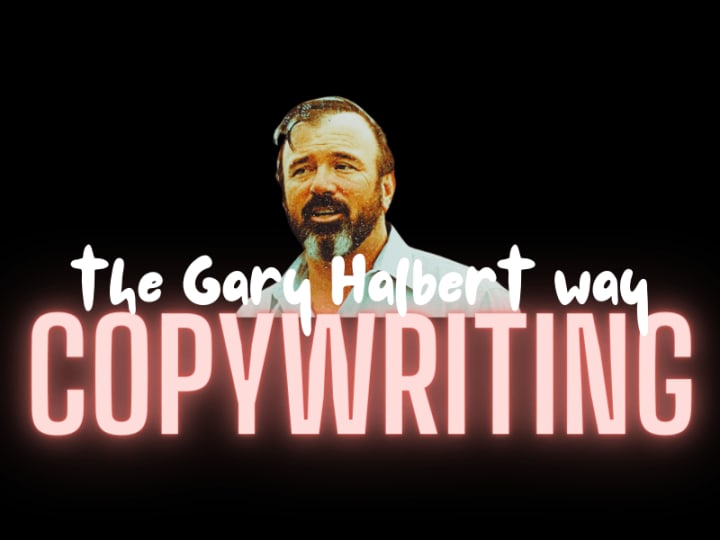How to write persuasive copy and win customers - the Gary Halbert way
Improve your copywriting straight away with these 10 tips based on Gary Halbert's method.

- Hey Will, the Internet is full of NOISE, how do I get people's attention?
- By writing persuasive copy.
- Er...and how do I do that?
- You learn from the masters, like Gary Halbert.
- But he died in 2007! Isn't his stuff outdated?
- His techniques still work. You just need to update them for the current web.
- Okay. When can I start?
- Right now. Let me say a bit about Gary Halbert, a bit about preparation, and then I'll teach you 10 practical copywriting tips based on Halbert's method.
- Awesome!
Who was Gary Halbert?
Gary Halbert (1938-2007) was a copywriter and marketing strategist known for what's called direct response marketing, which involves eliciting an instant response by encouraging prospective customers to take a specific action.
Halbert was known as "the prince of print" and the "world's greatest copywriter," because he wrote persuasive copy that led to successful sales letters and advertising campaigns.
Halbert was good at getting inside his audience's heads and speaking to their desires and concerns. Some of his best-selling books, such as The Boron Letters and How to Make Maximum Money in Minimum Time, have become classics in the field.
I like The Boron Letters for its unique format: it's a series of personal letters from Halbert to his son, Bond, where he really opens up the art and science of copywriting.
Before you write any copy do this:
Know your audience: Use tools like surveys, social media analytics, or customer feedback to understand your audience's preferences.
Know your product: Suppose you're promoting a productivity app. You need to know its strengths, like the palm of your hand.
Bring value to your audience: Whatever it is you're selling, your product must bring real value to your audience. Work on this the most.
10 Steps for writing effective copy based on Gary Halbert's teachings
Step 1: Create an Attention-Grabbing Headline
Example: "Double Your Productivity in 7 Days with Our Revolutionary App!"
Use compelling adjectives ("revolutionary") and a clear benefit ("double your productivity") to entice the audience.
Step 2: Open with a Hook
Example: "Imagine waking up every morning with a to-do list so manageable, you actually look forward to Mondays..."
Create a relatable scenario that draws the reader in emotionally.
Step 3: Highlight Benefits, Not Features
Instead of saying, "Our app has a sleek design," say, "Experience a seamless workflow with our intuitive app."
Clearly link the feature to a benefit the user will enjoy.
Step 4: Build Credibility
Example: "Trusted by over 1 million users worldwide, our app has been featured in Forbes and Wired."
Use social proof and endorsements to build credibility.
Step 5: Create Desire
Example: "What if you could complete your tasks effortlessly, leaving you more time for the things you love?"
Evoke emotions by describing the positive feelings associated with using your product.
Step 6: Overcome Objections
If a common objection is price, offer a money-back guarantee or a free trial to alleviate concerns.
Example: "Try it risk-free for 30 days and see the impact on your productivity. Money-back guaranteed."
Step 7: Add Urgency and Scarcity
Example: "Act now and get a 20% discount - limited to the first 100 subscribers!"
Create a sense of urgency and scarcity to prompt immediate action.
Step 8: Call to Action
Example: "Supercharge Your Productivity Today! Click here to start your 7-day free trial."
Use action verbs and make the CTA specific and compelling.
Step 9: Edit and Refine
Example: Trim excess words – "Experience the amazing benefits" to "Experience the benefits."
Ensure clarity and eliminate anything that doesn't add value.
Step 10: Test and Iterate
Example: Test two headlines - one emphasizing speed and the other emphasizing ease of use.
Analyze performance metrics to refine your copy based on what resonates with your audience.
Gary Halbert's famous "Coat of Arms" sales letter (1971)

Additional measures
Analyze Gary Halbert's Copy:
Example: Read Halbert's classic sales letter for "Coat of Arms." Note his use of storytelling and how he addresses the reader's desires and concerns.
Practice Writing Regularly:
Example: Write a daily 100-word ad for different products or scenarios to improve versatility.
Seek feedback from peers or mentors to refine your skills.
Learn from Your Mistakes:
Example: If a campaign doesn't perform well, analyze the data and adjust your approach.
Adapt and grow by understanding what didn't resonate with your audience.
By combining these practical steps, you can create persuasive copy that engages your audience and drives desired actions. You have to continuously refine your approach based on feedback and results for ongoing improvement.
Let me know what you think. Thanks for reading!
Related How-tos
How to write a killer sentence
In this writing workshop, we go back to basics and ask what makes a good sentence.

How to stay focused as a writer
Here are some simple tips on how to keep momentum while writing.

How to write a poem
This simple guide is a starting point for anyone interesting in writing poetry.

